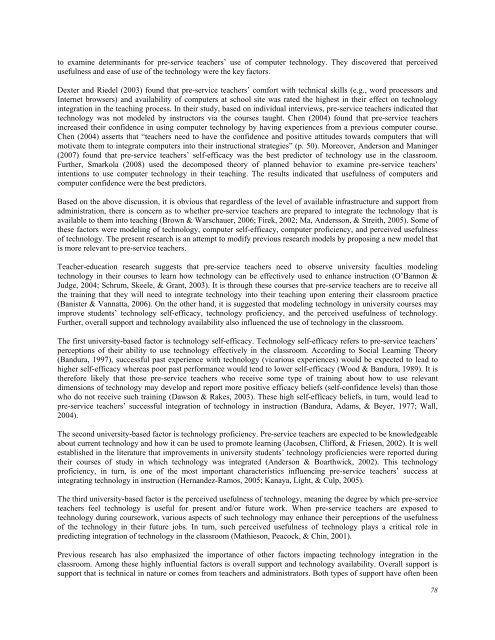October 2011 Volume 14 Number 4 - Educational Technology ...
October 2011 Volume 14 Number 4 - Educational Technology ...
October 2011 Volume 14 Number 4 - Educational Technology ...
You also want an ePaper? Increase the reach of your titles
YUMPU automatically turns print PDFs into web optimized ePapers that Google loves.
to examine determinants for pre-service teachers’ use of computer technology. They discovered that perceived<br />
usefulness and ease of use of the technology were the key factors.<br />
Dexter and Riedel (2003) found that pre-service teachers’ comfort with technical skills (e.g., word processors and<br />
Internet browsers) and availability of computers at school site was rated the highest in their effect on technology<br />
integration in the teaching process. In their study, based on individual interviews, pre-service teachers indicated that<br />
technology was not modeled by instructors via the courses taught. Chen (2004) found that pre-service teachers<br />
increased their confidence in using computer technology by having experiences from a previous computer course.<br />
Chen (2004) asserts that “teachers need to have the confidence and positive attitudes towards computers that will<br />
motivate them to integrate computers into their instructional strategies” (p. 50). Moreover, Anderson and Maninger<br />
(2007) found that pre-service teachers’ self-efficacy was the best predictor of technology use in the classroom.<br />
Further, Smarkola (2008) used the decomposed theory of planned behavior to examine pre-service teachers’<br />
intentions to use computer technology in their teaching. The results indicated that usefulness of computers and<br />
computer confidence were the best predictors.<br />
Based on the above discussion, it is obvious that regardless of the level of available infrastructure and support from<br />
administration, there is concern as to whether pre-service teachers are prepared to integrate the technology that is<br />
available to them into teaching (Brown & Warschauer, 2006; Firek, 2002; Ma, Andersson, & Streith, 2005). Some of<br />
these factors were modeling of technology, computer self-efficacy, computer proficiency, and perceived usefulness<br />
of technology. The present research is an attempt to modify previous research models by proposing a new model that<br />
is more relevant to pre-service teachers.<br />
Teacher-education research suggests that pre-service teachers need to observe university faculties modeling<br />
technology in their courses to learn how technology can be effectively used to enhance instruction (O’Bannon &<br />
Judge, 2004; Schrum, Skeele, & Grant, 2003). It is through these courses that pre-service teachers are to receive all<br />
the training that they will need to integrate technology into their teaching upon entering their classroom practice<br />
(Banister & Vannatta, 2006). On the other hand, it is suggested that modeling technology in university courses may<br />
improve students’ technology self-efficacy, technology proficiency, and the perceived usefulness of technology.<br />
Further, overall support and technology availability also influenced the use of technology in the classroom.<br />
The first university-based factor is technology self-efficacy. <strong>Technology</strong> self-efficacy refers to pre-service teachers’<br />
perceptions of their ability to use technology effectively in the classroom. According to Social Learning Theory<br />
(Bandura, 1997), successful past experience with technology (vicarious experiences) would be expected to lead to<br />
higher self-efficacy whereas poor past performance would tend to lower self-efficacy (Wood & Bandura, 1989). It is<br />
therefore likely that those pre-service teachers who receive some type of training about how to use relevant<br />
dimensions of technology may develop and report more positive efficacy beliefs (self-confidence levels) than those<br />
who do not receive such training (Dawson & Rakes, 2003). These high self-efficacy beliefs, in turn, would lead to<br />
pre-service teachers’ successful integration of technology in instruction (Bandura, Adams, & Beyer, 1977; Wall,<br />
2004).<br />
The second university-based factor is technology proficiency. Pre-service teachers are expected to be knowledgeable<br />
about current technology and how it can be used to promote learning (Jacobsen, Clifford, & Friesen, 2002). It is well<br />
established in the literature that improvements in university students’ technology proficiencies were reported during<br />
their courses of study in which technology was integrated (Anderson & Boarthwick, 2002). This technology<br />
proficiency, in turn, is one of the most important characteristics influencing pre-service teachers’ success at<br />
integrating technology in instruction (Hernandez-Ramos, 2005; Kanaya, Light, & Culp, 2005).<br />
The third university-based factor is the perceived usefulness of technology, meaning the degree by which pre-service<br />
teachers feel technology is useful for present and/or future work. When pre-service teachers are exposed to<br />
technology during coursework, various aspects of such technology may enhance their perceptions of the usefulness<br />
of the technology in their future jobs. In turn, such perceived usefulness of technology plays a critical role in<br />
predicting integration of technology in the classroom (Mathieson, Peacock, & Chin, 2001).<br />
Previous research has also emphasized the importance of other factors impacting technology integration in the<br />
classroom. Among these highly influential factors is overall support and technology availability. Overall support is<br />
support that is technical in nature or comes from teachers and administrators. Both types of support have often been<br />
78

















